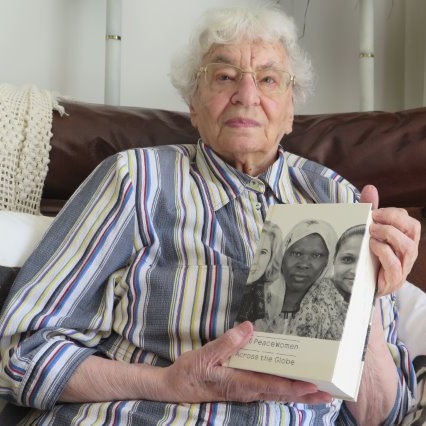click to dowload our latest edition
CLICK HERE TO SUBSCRIBE TO OUR NEWSLETTER


Published
5 years agoon
By
adminCHRISTINA STUCKY
In 1936, the notion that a school in the southern German town of Aschaffenburg would one day be named after a Jewess would have been preposterous. The 11½-year-old could not have guessed that she would meet people like Nelson Mandela, or become friends with Nobel Laureate Nadine Gordimer. She also could never have imagined that the apartheid government would bar her, and that she would contribute to bringing about the end of apartheid.
All that was unimaginable for a Jewish child in Germany in the 1930s. The department store founded by her uncle in Aschaffenburg was seized under Nazi “aryanisation” laws. Relatives were murdered, persecuted, or escaped in time. Among them her father, Richard Löwenthal, who fled to South Africa in 1933, after losing his job and following an invitation from relatives in Johannesburg. Her mother had a job, so she and Ruth stayed. Three years later, the Nuremberg race laws were in force, and her father urged them to join him. They made it out just in time.
Between 1933 and 1936, about 6 000 refugees from Nazi Germany arrived in South Africa before the ruling National Party barred Jews from entering the country. “The Nats at the time were pro-Hitler and close to Nazi ideology,” Ruth Weiss recalls. At first welcomed, the party eventually decided that Jews “had the right skin colour, but the wrong religion”.
Having attended a Jewish school in Fürth, and living there with her religious maternal grandparents during her last years in Germany, she grew up as a “conscious Jewess” in South Africa. “Partly because I had been made very aware of being one in the few years in Nazi Germany, partly because of the South African situation in the 30s and 40s. It was natural for me that my parents joined the German-Jewish synagogue founded by a group of immigrants.” She also joined a Zionist youth group.
Along with her religious beliefs, Ruth Löwenthal (later Weiss through marriage) brought a clear understanding of injustice to South Africa. On the boat to South Africa, she and her sister played with African children deck passengers picked up on the stops along the coast. “We thought we had to learn African languages and culture so we could live with them. But the first words I heard when I arrived in Cape Town were from a white woman who said, ‘Oh, how lovely that the children have such fair skin.’ That was a shock. We arrived in this country ignorant.” Twelve years later, apartheid became an institutionalised system of racial segregation.
“Other people had to work their way to the knowledge that apartheid was unjust,” she says. For Ruth Weiss’ family the injustice was apparent because of the Nazi persecution of “non-Aryans”.
When the first reports of the atrocities arrived from Germany, she recalls feeling an overwhelming sense of guilt. “We should have been there,” she writes in her autobiography, A Path Through Hard Grass. She also asked herself, “Is it permissible that the plight of the blacks touches me more than the monstrosities that happened to Jews in Europe? In South Africa, I constantly had the feeling that I shouldn’t be faring as well as I did. In view of the ever more obvious discrimination against blacks, I always had the feeling that I had failed.”
She abandoned her plans to emigrate to Palestine. Driven away by the increasing horror of apartheid, she left South Africa and embarked on a journalistic career that took her from London to Lusaka, Cologne to Harare, meeting Robert Mugabe, Mandela and other struggle stalwarts along the way. She was a business journalist, but reported equally on social and political issues. In 1968, she was declared persona non grata in Southern Rhodesia, where she was working at the time, and denied re-entry into South Africa.
In the 1980s, she was one of the founding members of the Zimbabwe Institute for Southern Africa, organising secret meetings with white and black South Africans and representatives of the liberation parties. “We brought people together who had learned to hate each other, furthering understanding and forging friendships across the barriers.” Her dedication to building bridges led her to be one of 1 000 women activists nominated for the Nobel Peace Prize in 2005.
After the end of apartheid, she visited South Africa several times in the early 1990s, but decided against returning. “It was the time for the young, the local, and returning leaders and activists. I felt an old woman like myself was superfluous to requirements.”
Today this nonagenarian uses her formidable memory and myriad experiences to speak out against prejudice. She has written 35 books and 46 unpublished manuscripts, including the children’s book My Sister Sara, set in South Africa. Many of her public talks return to the roots of her activism. Audiences often ask her about Nazi Germany or her thoughts as a Jewess about anti-Semitism in Germany. “The old prejudice against and lies about Jews, nurtured during centuries and reshaped to the extremes in the 30s, have never gone away. An old man said to me at a lecture, ‘They filled our heads with certain notions that are impossible to get rid of.’”
That the Aschaffenburg school carries her name has less to do with her than with Germany’s history, she asserts. “It’s an honour for me, but I know my name was chosen as a symbol of something that no longer exists. It’s a reminder of the once-thriving Jewish community that was completely eradicated.”
